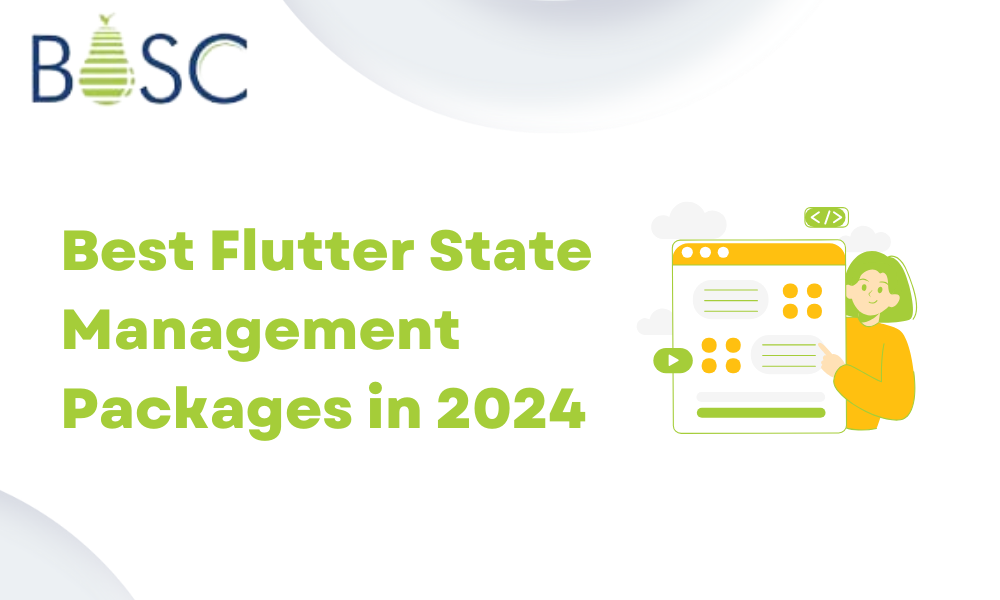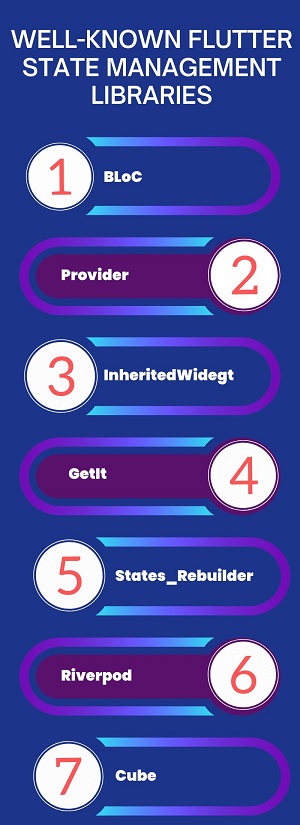
Flutter State Management Libraries in 2024
Flutter framework is used for web and mobile application development due to its cross-platform knowledge; the correct Flutter state management library is important to select during the development of an app. Here, we have listed out the best for you.
What is the state of Flutter?
The state is the synchronous information about the widget built when you develop the widget. This state changes all around the widget’s lifetime.
With the help of the top Flutter widgets, app functions can send and share data, and many other operations are carried out via a widget. Hence, when you redesign your UI with the aid of the data, that moment is referred to as the widget’s state.
For instance, we are working on the questionnaire app, and within this app, the following state occurs:
- When a user first registers, a page inside the app is updated per the user preference selected during the registration.
- Once a user enters the app, they will get the relevant questionnaire inside the app.
- After a user selects one questionnaire, data related to this test is updated, like the time taken, etc.
- After completing the paper, a user will receive the scores and rankings.
So, in all these states, UI updates with the help of the new data.
What is State management?
State management is vital whether you are building a mobile or web application. It refers to managing the state of one or more UI controls. UI controls can be radio buttons, toggles, text fields, and many more.
An app consists of many UI controls, and the state of one UI control depends on the state of the other UI controls. Every framework has its method to manage the state of UI controls.
Why do we require State Management?
State management is necessary for application development. It will centralize all the states of the different UI controls to handle the data flow across an application.
For instance, imagine that you want to view the “welcome” message on the user’s first-time visit but not on every page visit; you require the user’s state. When each page manages the user’s state, it increases code complexity and results in code duplication.
Or else consider showing a message on the button submission or handling the error message; in any case, the state and UI control are needed to take further actions.
Also Read: How to create a Typing Indicator in Flutter
Which problems have been solved By the State Management?
- How to handle a page when the user refreshes the browser URL?
- What to do when server data is updated or refreshed?
- How can the components or services be aware of the state?
- How is the request made to the server and then update on the page?
Managing the application’s state is one of the most vital processes. You can say what an application knows about a user, where they are, what information they have entered, and what UI controls are status after the user enters the data.
State management is done on both sides, i.e., frontend state management and backend state management.
What are the advantages of State Management Libraries?
Flutter architecture has proven to be self-sustainable when it comes to state management. The state management library is most probably used in complicated flutter application development. It offers some of the following advantages.

1. Smooth Operation
State management libraries help build the apps with enhanced efficiency and smooth data handling. It is directly linked to a user experience. Using these libraries grants you for the precise performance of all app functionalities and features.
2. Aligns core Business logic
The app’s effectiveness is at stake without a better state management library. It aligns the business logic with the servers and database. Moreover, users will find it more complex and challenging as it doesn’t utilize any state management library.
3. Centralize the code
It helps to minimize and maintain the long code base. It is easy for the developers to add quality to the code, which is more manageable and readable. However, new Flutter experts can easily pick up the code without much explanation.
Which are the leading Flutter State Management Libraries in 2024?

1. BLoC
It is the most essential and well-known Flutter state management library among developers. It will make the code easy to test and reuse by separating a presentation from the business logic. Using a BLoC with Flutter, expertise will reuse the components with the same applications. A uniform pattern and conventions permit the programmers to work on the same code base.
BLoC was developed to offer simple coding, support for creating robust applications, and seamless options for testing. It will successfully cater to these needs and regulates when and how the state changes throughout an application.
2. Provider
This library is seen as the wrapper around the InheritedWidget. It can also be used as part of the BLoC package to access the multiple objects in the widget tree. Providers will help you to deduct the boilerplate code by reducing the requirement to develop the new class every time.
It allows visibility of the state of an application in Flutter devtool. Apart from exposing a value, the Provider will enable the developers to create, dispose and listen to the same value or variable. It has various kinds of providers like ChangeNotifierProvider, StreamProvider, etc.
3. InheritedWidget
Flutter delivers the inherited widget, which will ease state management. Other classes inherit the class under the tree to access all the data. It will securely add interoperability in any app, and by doing so, it also creates the widgets on the top of the tree. InheritedWidget will work as the convenience class and allows users not to type the code in every child class to pass the down state. InheritedWidget is a very low widget as it lies at the bottom of the tree by using it for the state transitions and does not affect any other widgets.
4. GetIt
This classic service locator-based state management library will work well with Flutter projects. It can use to replace the InheritedWidget and the Provider, which accesses an app object from a user interface. GetIt makes the testing of the coding easy by delivering the mock class when it is needed. GetIt helps to organize and manage the code better by keeping the widgets from direct dependencies. It is the fastest state management option.
5. States_Rebuilder
This library focuses on getting four targets: clean code, better performance, user-friendly architecture, and it supports effective production. It will work by separating a user interface from the business logic and supporting mutable and immutable states.
It is a lightweight syntax that is easy to understand for new users. It also has an in-built dependency injection system. States_Rebuilder is robust enough that it is used for user authorization and authentication. A simple coding format will use the library; it is easy to test.
6. Riverpord
This state management library was created by the providers’ creators and aimed to solve issues of expertise using a framework. It will work as the implementation of the InheritedWidgetwhich is simple to understand and apply.
Riverpord helps the programmers catch the coding errors at the compile time rather than waiting for a run time. It will make the app’s object visible in the Flutter dev’s tool by default and build the apps more scalable with its unidirectional data flow. However, it makes patterns not dependent on Flutter and will simplify complicated object graphs.
7. Cube
Cube is the state management approach that utilizes a dependency injection and does not need code generation. Cube is very simple and easy to understand for new users and has gained popularity. It will focus on objectively managing the states. It will rebuild the widget tree when needed and reduce code complexity.
Conclusion
Choosing the proper state management library is as critical as using the one. Most app developers spend their valuable time on something other than dealing with the complicated boilerplate code; only simple state transitions can do this. We hope that this list of Flutter state management libraries has given you the information you were looking for.
At Bosc Tech Labs, we provide tailored Flutter app development services that will use the appropriate state management libraries per the need. Our developers will create the Flutter apps that will enhance the business market presence of the clients. Let’s get in touch with us to implement the mobile application.
Frequently Asked Questions (FAQs)
1. How many kinds of State Management are in Flutter?
In Flutter, state management is divided into two conceptual types: Ephemeral and App State.
2. What are the State Management tools?
It is the library or the set of libraries for creating a user interface in the Javascript apps. It implements a view in the MVC pattern with all the behaviors and the events supported. It is the tool that permits any developer to create the dynamic, but at a similar time, it adapts the web applications.
3. What is the State Management pattern?
It is the design pattern to share the state data across the components and separate the domain representation from the state management. This pattern is being applied by many of the well-known frameworks like Flux or Redux.
Hire Flutter App Developer
